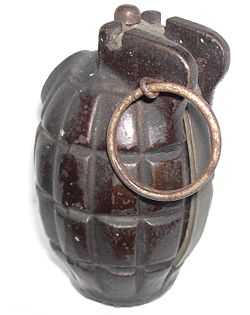- Mills bomb
-
Mills bomb 
Mills bomb 36M, dating from 1942Type Hand grenade Place of origin  United Kingdom
United KingdomService history In service May, 1915–1970s Production history Designed 1915 Number built 70 million + Variants No. 5, No. 23,
No. 36, No. 36MSpecifications Weight 765 grams Length 95.2 Diameter 61 Filling Baratol Detonation
mechanism7 seconds,
later reduced to 4Mills bomb is the popular name for a series of prominent British hand grenades. They were the first modern fragmentation grenades in the world.
Contents
Overview
William Mills, a hand grenade designer from Sunderland, patented, developed and manufactured the "Mills bomb" at the Mills Munition Factory in Birmingham, England, in 1915.[1] The Mills bomb was adopted by the British Army as its standard hand grenade in 1915, and designated as the No. 5.[2] It was also used by the Irish Republican Army.
The Mills bomb underwent numerous modifications. The No. 23 was a variant of the No. 5 with a rodded base plug which allowed it to be fired from a rifle. This concept evolved further with the No. 36, a variant with a detachable base plate to allow use with a rifle discharger cup. The final variation of the Mills bomb, the No. 36M, was specially designed and waterproofed with shellac[2] for use initially in the hot climate of Mesopotamia in 1917, but remained in production for many years. By 1918 the No. 5 and No. 23 were declared obsolete and the No. 36 (but not the 36M) followed in 1932.
The Mills was a classic design; a grooved cast iron "pineapple" with a central striker held by a close hand lever and secured with a pin. Although the segmented body helps to create fragments when the grenade explodes, according to Mills' notes the casing was grooved to make it easier to grip and not as an aid to fragmentation. The Mills was a defensive grenade: after throwing the user had to take cover immediately. A competent thrower could manage 15 metres (49 feet) with reasonable accuracy, but the grenade could throw lethal fragments farther than this. It could be fitted with a flat base and fired with a blank cartridge from a rifle with a "cup" attachment, giving it a range of around 150 m.
At first the grenade was fitted with a seven-second fuse to accommodate both hand and rifle launch, but during combat in the Battle of France in 1940 this delay proved too long—giving defenders time to escape the explosion, or even to throw the grenade back—and was reduced to four seconds.
The heavy, segmented bodies of "pineapple" type grenades result in an unpredictable pattern of fragmentation. After the Second World War Britain and the US adopted grenades that contained segmented coiled wire in smooth metal casings. The No. 36M Mk.I remained the standard grenade of the British Armed Forces and was manufactured in the UK until 1972, when it was completely replaced by the L2 series. The 36M remained in service in some parts of the world such as India and Pakistan, where it was manufactured until the early 1980s. That the Mills bomb remained in use for so many years says much about its effectiveness.
Gallery
References
- ^ U.S. Patent 1,178,092 U.S. copy of the 1915/1916 Mills grenade patent
- ^ a b "www.firstworldwar.com - Who's Who - Sir William Mills". http://www.firstworldwar.com/bio/mills.htm.
External links
- WWII Tech Pubs Briefing[dead link]
- Photos of late production 36M grenades—including one made in 1972
- Cross section of a Mills Bomb
Anti-personnel Grenade, No 1 · No 2 grenade "Hales Pattern" · Nos. 3, 20, 24, 35 "Hales Rifle Grenade" · Nos. 5, 23, 36 Mills · No. 6 grenade · No. 15 Ball grenade · No. 69 · Nos. 8, 9 Double Cylinder Jam TinAnti-tank Special Types British & Commonwealth small arms of World War II and KoreaSide-arms Rifles & submachine guns SMLE No.1 Mk III* & Lee-Enfield No.4 Mk.I · Pattern 1914 Enfield · Lee-Enfield No.5 Mk.I "Jungle Carbine" · De Lisle Commando Carbine · Sten · Lanchester · Austen · Owen Gun · Welgun · M1921/M1928/M1 ThompsonMachine-guns &
other larger weaponsBren Gun · Charlton Automatic Rifle · Lewis Gun · Vickers MG · PIAT · Rifle, Anti-Tank, .55 in, Boys · SBML 2inch Mortar · ML 3-inch Mortar · No.2 "Lifebuoy" FlamethrowerGrenades British grenades of WWI and WW2 · Mills BombSmall arms cartridges US infantry weapons of World War ISide arms Rifles Automatic rifles Grenades Shotguns Machine guns and larger Cartridges Categories:- World War I grenades of the United Kingdom
- World War II British infantry weapons
- World War II grenades of the United Kingdom
Wikimedia Foundation. 2010.






